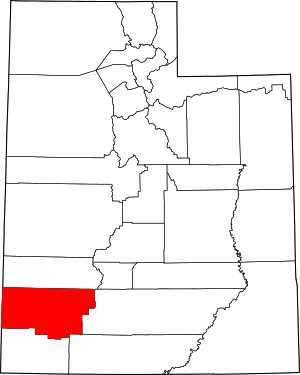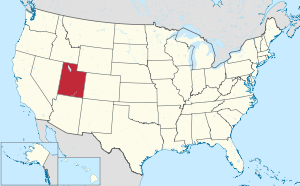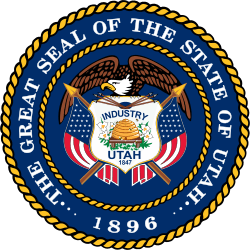Iron County, Utah
Iron County is a county in southwestern Utah, United States. As of the 2010 United States Census, the population was 46,163.[1] Its county seat is Parowan,[2] and the largest city is Cedar City.
Iron County | |
|---|---|
 The Parowan Gap petroglyphs, a well-known landmark in Iron County, July 2007 | |
 Location within the U.S. state of Utah | |
 Utah's location within the U.S. | |
| Coordinates: 37.86°N 113.28°W | |
| Country | |
| State | |
| Founded | January 31, 1850 (created) January 17, 1851 (organized) |
| Named for | Iron mines |
| Seat | Parowan |
| Largest city | Cedar City |
| Area | |
| • Total | 3,301 sq mi (8,550 km2) |
| • Land | 3,297 sq mi (8,540 km2) |
| • Water | 4.4 sq mi (11 km2) 0.1% |
| Population (2010) | |
| • Total | 46,163 |
| • Estimate (2019) | 54,839 |
| • Density | 16.6/sq mi (6.4/km2) |
| Time zone | UTC−7 (Mountain) |
| • Summer (DST) | UTC−6 (MDT) |
| Congressional district | 2nd |
| Website | www |
The Cedar City, UT Micropolitan Statistical Area includes all of Iron County.
History
Evidence of Fremont culture habitation ranging from 750 to 1250 AD exists in present Iron County. Petroglyphs of differing periods were carved into the walls of Parowan Gap NW of Parowan. Paiutes roamed the Parowan Valley in the centuries prior to Euro-American exploration; their descendants are now represented by the Southern Paiute Indian Reservation, which is headquartered in Cedar City.
The Domínguez–Escalante expedition traveled through the Iron County area on October 12, 1776. Fur trapper Jedediah Smith is the first recorded Anglo-American to pass through the area (1826). Settlement of the area began in 1851, when LDS President Brigham Young directed members from the northern colonies to move into the area. A settlement, Coal Creek, sprang up in 1851; it later became Cedar City.[3] To provide a local government structure, the State of Deseret legislature created the county on January 31, 1850, although it was not organized until January 17, 1851, with description stretching from the future Colorado, across Utah, and into the future Nevada. It was named "Little Salt Lake County" at creation, but on December 3, 1850, a legislative act changed its name to Iron County. Its borders were altered in 1850, 1852, 1854, 1856, and 1861. Also in 1861, the federal government created the Colorado Territory, which administratively removed Iron County areas east of 109 degrees longitude.
The county borders were altered in 1862. Also in 1862, the federal government created the Nevada Territory, which administratively removed Iron County areas west of 114 degrees longitude. Further boundary adjustments were passed in 1866, 1880, 1882, 1883, and 1884. The final adjustment was made in 1892; the county borders have remained in their present arrangement since that time.[4]
Geography
Iron County lies on the west edge of Utah. Its west border abuts the east border of the state of Nevada. The Iron County terrain is a study in contrast from its arid western reaches of Escalante Desert and Great Basin ranges to the meadows and forests of the High Plateau on the east. The Markagunt Plateau is creased by the colorful formations of Cedar Breaks National Monument. Brian Head Peak is the county's highest point, at 11,307' (3446m) ASL.[3] The county has a total area of 3,301 square miles (8,550 km2), of which 3,297 square miles (8,540 km2) is land and 4.4 square miles (11 km2) (0.1%) is water.[5]
Major highways
Adjacent counties
- Beaver County - north
- Garfield County - east
- Kane County - southeast
- Washington County - south
- Lincoln County, Nevada - west
Protected areas
Lakes
- Little Salt Lake
- Newcastle Reservoir
- Quichapal Lake[6]
| Historical population | |||
|---|---|---|---|
| Census | Pop. | %± | |
| 1850 | 360 | — | |
| 1860 | 1,010 | 180.6% | |
| 1870 | 2,277 | 125.4% | |
| 1880 | 4,013 | 76.2% | |
| 1890 | 2,683 | −33.1% | |
| 1900 | 3,546 | 32.2% | |
| 1910 | 3,933 | 10.9% | |
| 1920 | 5,787 | 47.1% | |
| 1930 | 7,227 | 24.9% | |
| 1940 | 8,331 | 15.3% | |
| 1950 | 9,642 | 15.7% | |
| 1960 | 10,795 | 12.0% | |
| 1970 | 12,177 | 12.8% | |
| 1980 | 17,349 | 42.5% | |
| 1990 | 20,789 | 19.8% | |
| 2000 | 33,779 | 62.5% | |
| 2010 | 46,163 | 36.7% | |
| Est. 2019 | 54,839 | 18.8% | |
| US Decennial Census[7] 1790–1960[8] 1900–1990[9] 1990–2000[10] 2010–2018[1] 2019[11] | |||
2000 census
As of the 2000 United States Census, there were 33,779 people, 10,627 households, and 8,076 families in the county. The population density was 10.25/sqmi (3.96/km²). There were 13,618 housing units at an average density of 4.13/sqmi (1.59/km²). The racial makeup of the county was 93.00% White, 0.35% Black or African American, 2.18% Native American, 0.74% Asian, 0.27% Pacific Islander, 1.78% from other races, and 1.67% from two or more races. 4.09% of the population were Hispanic or Latino of any race. The top 5 Ethnic groups in Iron County are:
There were 10,627 households out of which 41.00% had children under the age of 18 living with them, 64.20% were married couples living together, 8.50% had a female householder with no husband present, and 24.00% were non-families. 15.90% of all households were made up of individuals and 5.90% had someone living alone who was 65 years of age or older. The average household size was 3.11 and the average family size was 3.45.
The county population contained 31.20% under the age of 18, 20.60% from 18 to 24, 23.60% from 25 to 44, 16.10% from 45 to 64, and 8.60% who were 65 years of age or older. The median age was 24 years. For every 100 females, there were 98.40 males. For every 100 females age 18 and over, there were 93.60 males.
The median income for a household in the county was $33,114, and the median income for a family was $37,171. Males had a median income of $30,800 versus $19,831 for females. The per capita income for the county was $13,568. About 13.10% of families and 19.20% of the population were below the poverty line, including 20.40% of those under age 18 and 6.50% of those age 65 or over.
Recreation
- Woods Ranch Recreation Area,[12] a recreation area located in a pine/aspen forest with hiking, fishing, picnic areas, a volleyball court and restroom facilities.
- Three Peaks Recreation Area,[13] a recreation area made up of volcanic rock and hills. The area features rock climbing, picnics, fishing, off-road vehicle use and bike riding.
- Shooting Range[14]
- Brian Head Ski Resort
Politics
Iron County is a strongly Republican County in Presidential elections, having not voted Democratic since 1936.
| Year | Republican | Democratic | Third parties |
|---|---|---|---|
| 2016 | 64.8% 11,561 | 13.7% 2,450 | 21.4% 3,820 |
| 2012 | 84.5% 14,200 | 12.8% 2,148 | 2.8% 463 |
| 2008 | 75.1% 12,518 | 19.5% 3,258 | 5.4% 902 |
| 2004 | 83.0% 12,815 | 14.7% 2,267 | 2.4% 364 |
| 2000 | 80.2% 10,106 | 14.2% 1,789 | 5.6% 699 |
| 1996 | 69.8% 6,550 | 20.1% 1,887 | 10.2% 954 |
| 1992 | 59.9% 5,616 | 16.4% 1,537 | 23.7% 2,225 |
| 1988 | 76.7% 6,038 | 22.1% 1,736 | 1.2% 94 |
| 1984 | 83.1% 6,856 | 16.3% 1,342 | 0.6% 53 |
| 1980 | 79.5% 6,207 | 15.9% 1,242 | 4.6% 355 |
| 1976 | 69.6% 4,757 | 24.9% 1,700 | 5.5% 376 |
| 1972 | 76.5% 5,085 | 16.5% 1,098 | 7.0% 465 |
| 1968 | 66.6% 3,337 | 23.1% 1,157 | 10.3% 517 |
| 1964 | 55.1% 2,522 | 44.9% 2,053 | |
| 1960 | 63.9% 3,079 | 36.1% 1,738 | 0.0% 1 |
| 1956 | 71.7% 3,321 | 28.3% 1,311 | |
| 1952 | 66.6% 3,175 | 33.5% 1,596 | |
| 1948 | 58.5% 2,289 | 40.8% 1,596 | 0.7% 26 |
| 1944 | 53.3% 1,930 | 46.3% 1,677 | 0.4% 14 |
| 1940 | 51.5% 2,060 | 47.9% 1,915 | 0.6% 23 |
| 1936 | 42.4% 1,396 | 56.1% 1,844 | 1.5% 49 |
| 1932 | 50.6% 1,599 | 42.9% 1,358 | 6.5% 206 |
| 1928 | 72.1% 1,823 | 27.0% 682 | 0.9% 23 |
| 1924 | 66.5% 1,429 | 22.6% 485 | 11.0% 236 |
| 1920 | 69.6% 1,399 | 27.9% 561 | 2.5% 50 |
| 1916 | 40.0% 825 | 56.1% 1,156 | 3.9% 80 |
| 1912 | 49.7% 695 | 38.9% 544 | 11.4% 159 |
| 1908 | 55.8% 712 | 38.2% 488 | 6.0% 76 |
| 1904 | 58.7% 741 | 35.0% 442 | 6.3% 79 |
| 1900 | 46.9% 628 | 52.9% 708 | 0.2% 2 |
| 1896 | 20.3% 205 | 79.7% 806 |
Communities
Cities
- Cedar City
- Enoch
- Parowan (county seat)
Census-designated places
Unincorporated places
- Beryl
- Hamiltons Fort
- Hamlin Valley
- Lund
- Modena
- Old Irontown
Former communities
- Gold Springs
- Iron Springs
- Uvada
- Zane
See also
References
- "State & County QuickFacts". United States Census Bureau. Archived from the original on June 6, 2011. Retrieved December 29, 2013.
- "Find a County". National Association of Counties. Archived from the original on May 31, 2011. Retrieved June 7, 2011.
- Iron County Profile (accessed 31 March 2019)
- "Utah: Individual County Chronologies". Utah Atlas of Historical County Boundaries. Newberry Library. 2008. Retrieved June 26, 2015.
- "2010 Census Gazetteer Files". US Census Bureau. August 22, 2012. Retrieved June 25, 2015.
- Iron County UT Google Maps (accessed 30 March 2019)
- "US Decennial Census". United States Census Bureau. Archived from the original on April 26, 2015. Retrieved June 25, 2015.
- "Historical Census Browser". University of Virginia Library. Retrieved June 25, 2015.
- Forstall, Richard L., ed. (June 25, 1995). "Population of Counties by Decennial Census: 1900 to 1990". US Census Bureau. Retrieved March 27, 2015.
- "Census 2000 PHC-T-4. Ranking Tables for Counties: 1990 and 2000" (PDF). US Census Bureau. April 2, 2001. Retrieved June 25, 2015.
- "QuickFacts. Utah counties". Retrieved May 17, 2020.
- "Archived copy". Archived from the original on May 8, 2014. Retrieved May 30, 2014.CS1 maint: archived copy as title (link)
- "Archived copy". Archived from the original on May 8, 2014. Retrieved May 30, 2014.CS1 maint: archived copy as title (link)
- "Archived copy". Archived from the original on December 19, 2013. Retrieved May 30, 2014.CS1 maint: archived copy as title (link)
- Leip, David. "Atlas of US Presidential Elections". uselectionatlas.org. Retrieved March 31, 2018.

